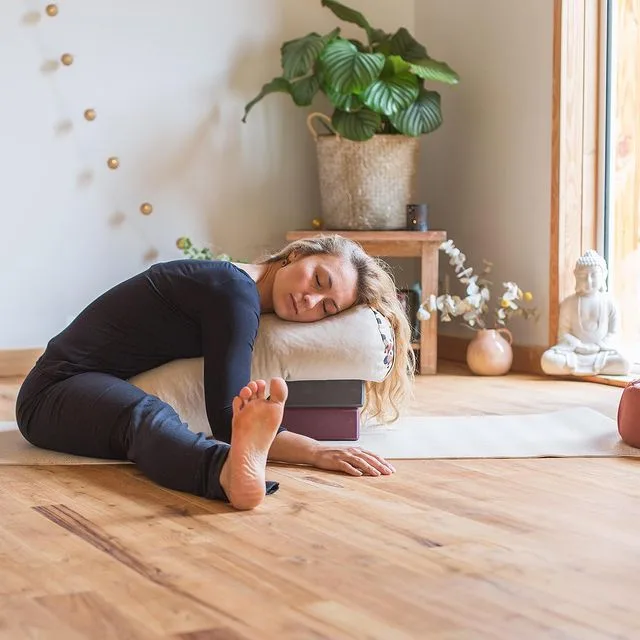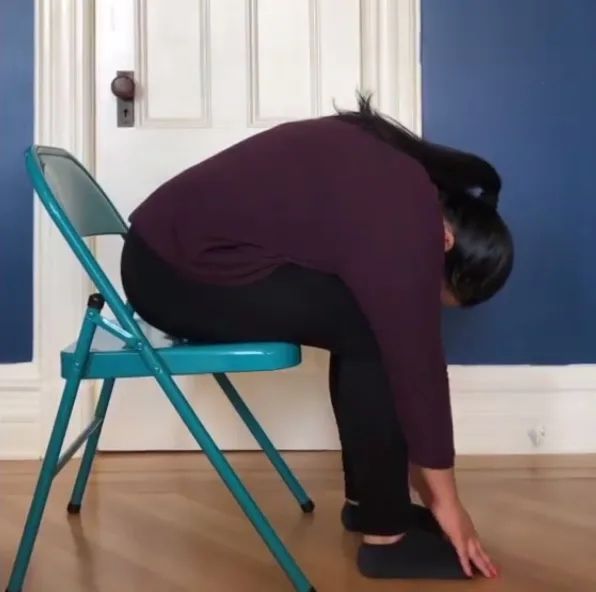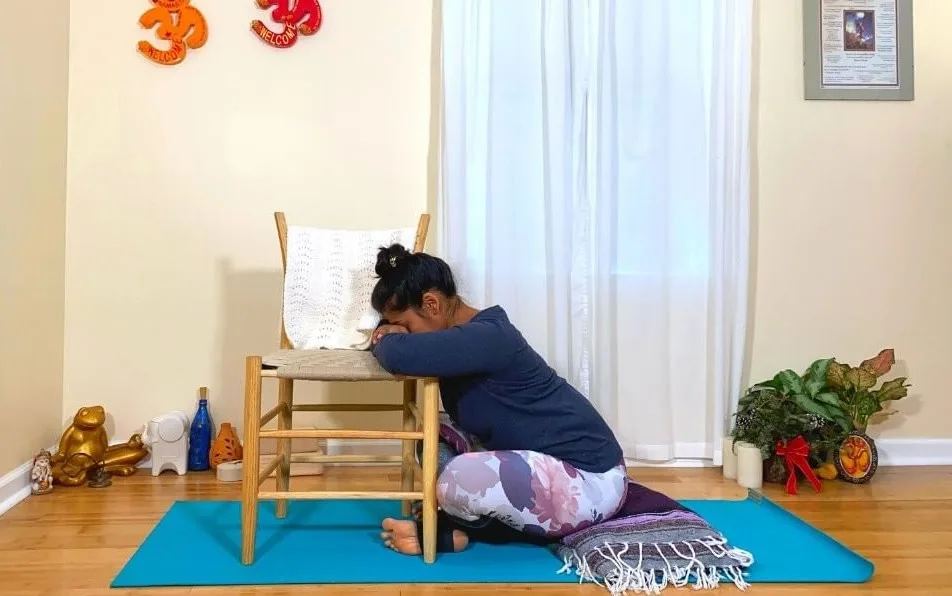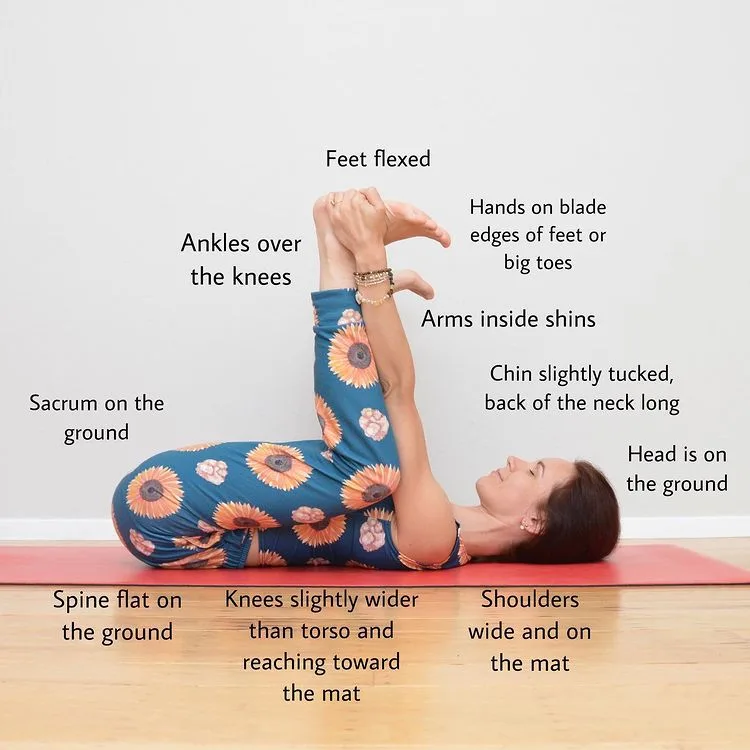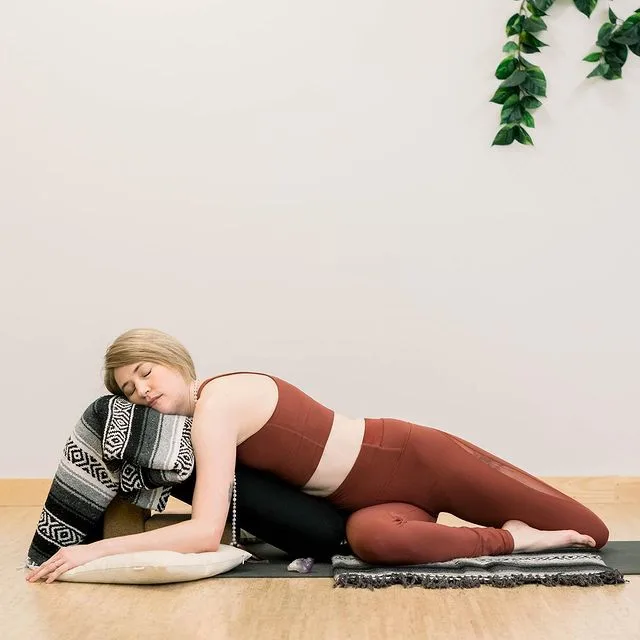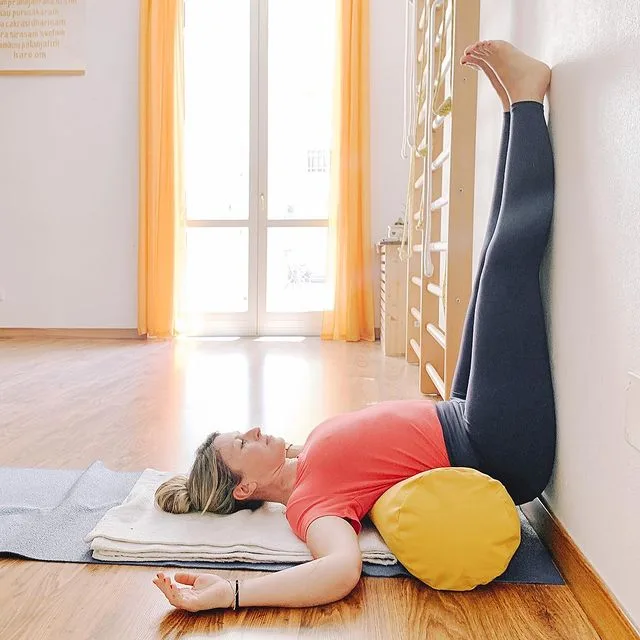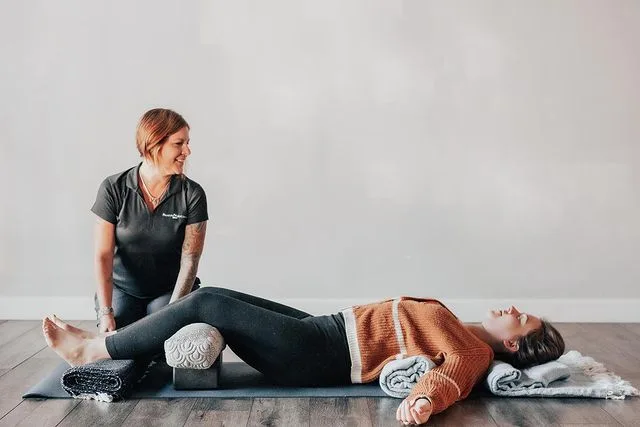Supported Seated Angle Pose or Supported Upavistha Konasana calms mental arousal and can be practiced to relieve headaches or insomnia.
Information
| Known as: | Supported Seated Angle Pose, Supported Upavistha Konasana, Supported Wide Angle Seated Pose |
| Level: | Beginner |
| Type: | Forward-Bend, Relaxation, Restorative Pose |
| Total time: | 3 to 10 minutes |
| Drishti: | Eyes closed |
| Chakra: | Swadisthana Chakra, Muladhara Chakra |
| Focus: | Legs, spine |
| Indications: | menstrual cycle, pregnancy, headaches or insomnia, detoxify kidneys, intestines, liver, arthritis |
| Preparatory poses: | Simple Supported Back Bend Pose, Elevated Legs-Up-the-Wall Pose, Reclining Twist with a Bolster (Supported Bharadvaja Twist Pose) |
| Follow-up poses: | Basic Relaxation Pose, Mountain Brook Pose (Salamba Matsyasana Blankets) |
| Contraindications: | Knees, neck pain, disc disease, or chronic sacroiliac dysfunction |
Benefits of Supported Seated Angle Pose or Supported Upavistha Konasana
In general, leaning forward calms the organs of digestion and elimination, such as the stomach, intestines, and liver. Women often find this pose especially pleasant during their menstruation and during pregnancy. If you are pregnant, make sure there is space between the chair and your tummy so that you and your baby are comfortable.
In addition, this pose balances the squeezing effect on the spine and kidneys that make up the back-bending pose. As a counterbalancing movement to arch the back, this pose opens up the lower back. Supported Seated Angle Pose calms mental agitation and can be practiced to relieve headaches or insomnia.
Supported Seated Angle Pose or Supported Upavistha Konasana Practice Guide
This Restorative Pose is traditionally used to stretch the legs. It is also recommending that even very flexible individuals practice this supported variation to increase relaxation. You don’t need to work out aggressively to reap the physical benefits of the pose.
Equipment needed
- Prop:
- Optional props:
- Towel
- Chair
- Extra blanket for warmth
- 1 or more single-fold blanket
- Clock or timer
Step-by-step Instructions to Supported Seated Angle Pose
Step-1
Sit on the floor, keep your feet apart and bolster between them. Don’t put your feet so far apart that you extend your inner knees. If you feel inner knee discomfort, bring your feet together until the discomfort subsides, and you only feel a stretch in your thighs. Whether you feel discomfort in one inner knee or both, bring both feet in so that each is equidistant from the midline of the body.
Step-2
If you can maintain the natural inward curve of your lumbar spine positioned at your waist level, you can move on. If your lower back feels dizzy, sit on the corner of a single-fold blanket. This will raise the pelvis and tilt it forward to maintain the lumbar curve. Feel free to increase the height of the blanket, so you can lean forward without strain.
Step-3
- Once comfortably seated, lean forward and rest the torso, arms, and head on the bolster. There are three possible positions for your arms and head. As always, experiment and choose what suits you best.
- You can: Bend your arms and rest your forehead on them or turn your head to one side; rest your arms on the bolsters, bent or detached from your head; Or rest your head on the bolster and rest your arms on the floor with the bolster.
Step-4
Relax your neck and throat. Move your chin slightly towards your chest, so that the back of your neck is longer.
Step-5
- Remember, the purpose of this pose is not to stretch, but to open up. If you’re less flexible and can’t rest easily on the bolster, come up and increase the height of the support by adding 1 or more single-fold blankets. You can also place a folded towel under your head.
- Another option: Use a chair. You can lean forward and rest on the seat, add 1 or more single-fold blankets to the seat of the chair until you are comfortable, If it’s still too tense, turn the chair around and rest it on its back.
Step-6
As with all forward bends, the Supported Seated Angle Pose can strain your lower back. This is usually alleviated by sitting on a support high enough to tilt the pelvis forward. For some people, however, the sacroiliac joint is still enlarged. Sacroiliac stimulation is often experienced as a circle of pain the size of a quarter or fifty percent piece on the left or right side of the sacrum.
Step-7
If you feel sacroiliac pain in this pose, you may find relief by adjusting your body slightly asymmetrically with a bolster or chair. Turn your body slightly to one side and lean forward again. If this doesn’t ease or worsens the pain, turn slightly to the other side. If neither adjustment relieves pain or discomfort, skip this pose and seek the advice of your health care professional regarding your sacroiliac alignment. If you are able to move on, close the eyes.
Step-8
Breathe normally. Allow your body to be fully supported by the props. Feel the sensations of your body, as the outside world fades away. Imagine you are entering a temple, where you can lay down your burden and rest in peace. There is no demand on you now. Allow your abdomen and chest to soften as you breathe easily and freely.
Step-9
Practice the supported seated-angle pose for 3 to 5 minutes; Those with more experience can last up to 10 minutes. When you feel ready, open your eyes and relax for a few breaths. Place your hands on the bolter or chair, and use the strength of your arms to slowly squat down. Place your hands behind you, and lean back to relax your back.
Precautions and contraindications
- Take extreme care to create comfort for your neck, lower back and knees in a Supported Seated Angle Pose.
- If you experience discomfort in any of these areas after experimenting with props height and placement, do not practice this yoga pose.
- If you experience neck pain or discomfort during or after this pose, make sure that the neck does not sag, but that you maintain the normal cervical curve, as you do when standing upright.
- If you experience pain or discomfort in one or both inner knees, bring your feet closer together, as described in the Step-by-step Instructions. If the pain persists, do not practice this pose for a few days and then try it again. If you still experience pain or discomfort, consult your health care professional.
- If you have disc disease in your lower back or chronic sacroiliac dysfunction, decrease the height of the props below your sit bones and increase the height of the bottom of your head and chest.
- You should not feel any sacroiliac pain or discomfort, if you do, try the adjustments described in the Step-by-step Instructions. If they fail to ease the discomfort, leave this pose for now.


